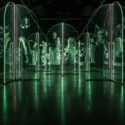Last Friday was the opening of a new and immersive in situ exhibition by Spanish artist Gonzalo Borondo at the Esteban Vicente Museum of Contemporary Art in Segovia, Spain.
The new exhibition follows the steps of earlier works in Italy and later in France where the appropriation of historic spaces like the cemetery chapel of the small village of Selci (“Cenere”, 2017), the 4,000 sq. meter of the Marseille old Flea Market (“Matière Noire”, 2018), and the Temple des Chartrons in Bordeaux, which had been closed for the last forty years (“Merci”, 2019) is central, creating intimate dialogues with the context through multisensory experiences.
With Hereditas, Borondo takes his research a step further by immersing himself in a three-story “white cube”, located in an Renaissance building from 1455, which has been witness to Segovia’s rich history. Originally the city palace of the controversial King Enrique IV of Castile (known as the Impotent), the building passed from the hands of the city’s most noble families, to become an old people’s hospice in 1518, a School of Arts and Crafts, a Museum of Sacred Art before being totally renovated by the architect Juan Ariño who took into account the few remaining historical remnants and carefully placed within the urban environment and surroundings of the palace. It is in this setting that Gonzalo Borondo creates HEREDITAS, approaching the space without preconceived ideas and inspired by the building’s different layers of history, the city of Segovia where he grew up, and the memories of his father, a conservator.
It is in this setting that Gonzalo Borondo creates HEREDITAS, approaching the space without preconceived ideas and inspired by the building’s different layers of history, the city of Segovia where he grew up, and the memories of his father, a conservator.
 Although the idea is to approach the space without preconceived ideas, the exhibition aims to question the past on the basis of, exactly, present presuppositions, in particular to recognise the museum as a place to preserve our cultural heritage for future generations and to show art’s amazing capacity to bring back to life objects that have lost their original purpose; in addition, it pays tribute to nature, as the foundation of culture and inspiration of art and religious symbols.
Although the idea is to approach the space without preconceived ideas, the exhibition aims to question the past on the basis of, exactly, present presuppositions, in particular to recognise the museum as a place to preserve our cultural heritage for future generations and to show art’s amazing capacity to bring back to life objects that have lost their original purpose; in addition, it pays tribute to nature, as the foundation of culture and inspiration of art and religious symbols. The artist has recovered original relics from the past (sculptures, columns, plaster pieces, niches, etc.), which intermingle and become one with his contemporary interpretations. He thereby shifts the classic focus of the contemporary art museum, mostly oriented towards envisioning the future, into a broad consideration of the past.
The artist has recovered original relics from the past (sculptures, columns, plaster pieces, niches, etc.), which intermingle and become one with his contemporary interpretations. He thereby shifts the classic focus of the contemporary art museum, mostly oriented towards envisioning the future, into a broad consideration of the past.
 From a contemporary art standpoint, HEREDITAS is a site-specific creation, a set of installations, an exhibition of exhibitions, it is a choral work breaking with the logic we are accustomed to. The emotional journey disrupts the viewer’s conventional route, providing surprises and moments of true sensorial pleasure, transforming the visit into an experience that persists in time.
From a contemporary art standpoint, HEREDITAS is a site-specific creation, a set of installations, an exhibition of exhibitions, it is a choral work breaking with the logic we are accustomed to. The emotional journey disrupts the viewer’s conventional route, providing surprises and moments of true sensorial pleasure, transforming the visit into an experience that persists in time.
Collaborators
Using multiple languages and media (installations, painting, projections, animations, holograms, sound effects, etc.), he is accompanied by his unfailing team of ultra-specialised and unbridled experimenters (in particular 56fili, the master of serigraphy printed on the most unlikely media, or the alchemist Flavio Lancia) with whom he explores and plays with the materials found on site. Combining traditional manual techniques with ultra-sophisticated technologies he achieves a body of work that brings back the soul and memory of the place.
GONZALO BORONDO was born in Valladolid in 1989. Shortly after, he moved to Segovia, where he grew up and lived until 2003, when he left for Madrid. Since then, graffiti, activism and alternative art groups became his real school. His work on urban space began with political aims, and later took on a more poetic bent, with works in USA, Europe and even India.
Since 2010 he has shown an interest in establishing affective and disruptive dialogues in very disparate spaces. As of 2012, individual exhibitions in Rome, Madrid, Paris and London have been key to his career. For the past four years he has focused on making site-specific projects resulting from dialogue with the context of the intervened space.
For some of these interventions he has had the collaboration of other artists, who have enhanced the project through their technical and creative skills. Such collaborations have added a curatorial aspect to his latest projects. The heterogeneity of Borondo’s work prevents giving his work a specific style or genre.
Images of the exhibition: Roberto Conte – (FB) Il Conte Photography (IG) @ILCONTEPHOTOGRAPHY
Images work in progress: Aruallan – (IG) @aruallan (FB) @ Aruallan Pic

























You must be logged in to post a comment.